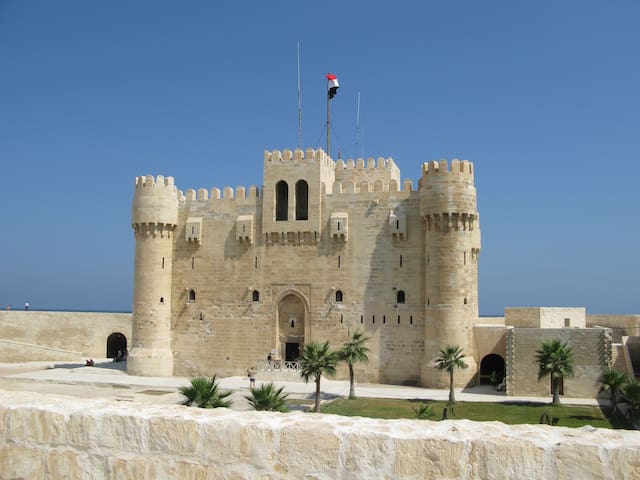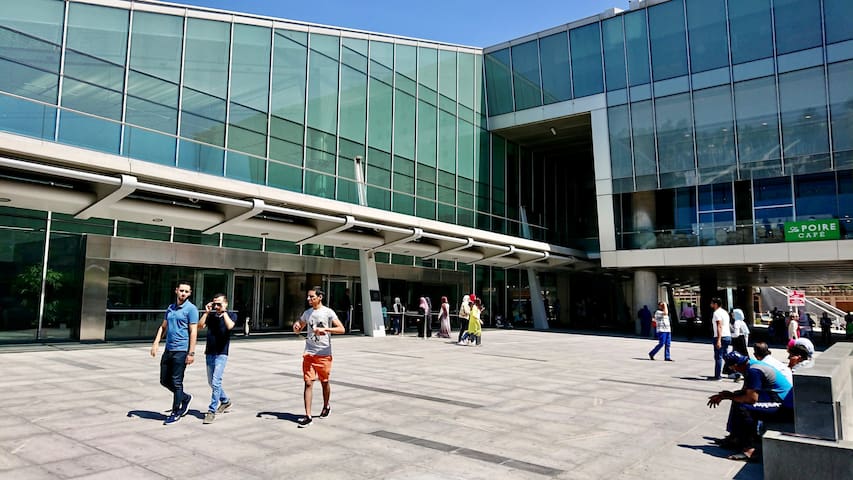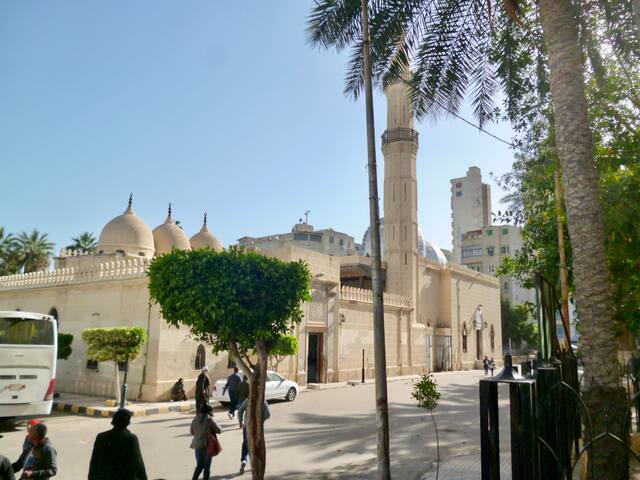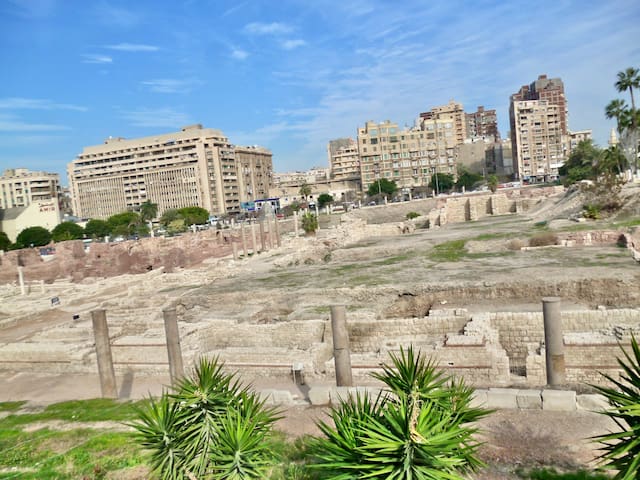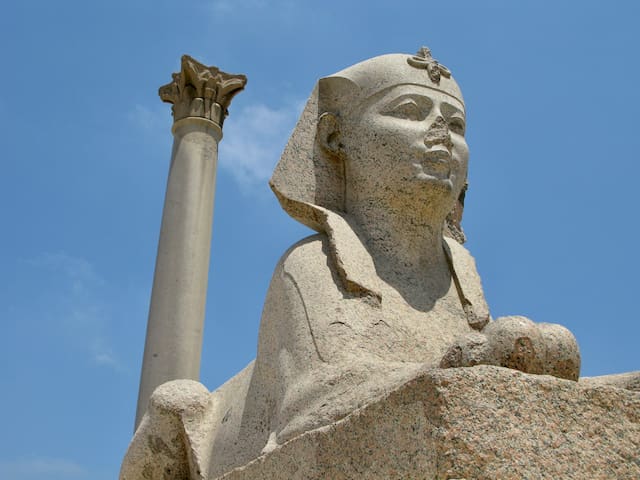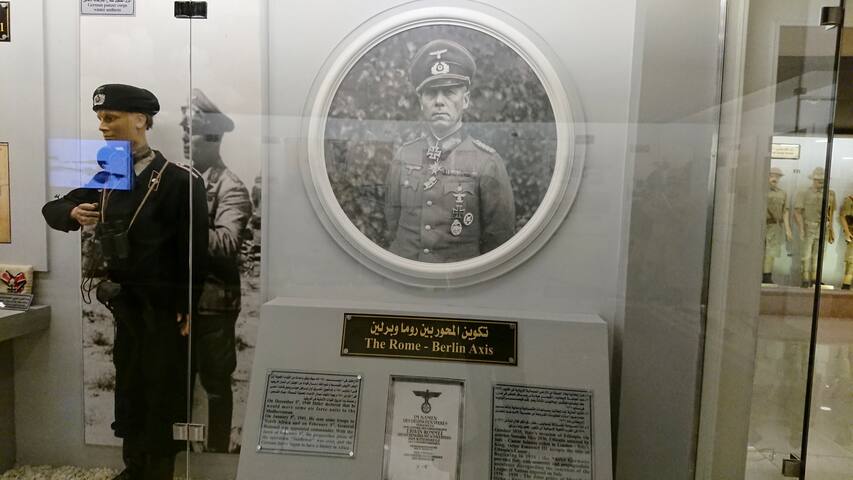Sightseeing
Citadel of Qaitbay
The Qaitbay Citadel in Alexandria is not only one of the most significant defensive fortifications in Egypt, but also around the Mediterranean Sea coast. It was built in the 15th century AD by Sultan Al-Ashraf Sayf al-Din Qa'it Bay to defend Alexandria from the Ottoman Empire and other potential invaders. The citadel's strategic location at the entrance to the eastern harbor made it an important military stronghold.
Alexandria's Lighthouse
The Citadel of Qaitbay was built on the exact location of the famed Alexandria Lighthouse, which was one of the Seven Wonders of the Ancient World. The lighthouse was constructed during the Ptolemaic dynasty in the 3rd century BC and stood at an estimated height of 100-135 meters. It was a beacon for sailors and a symbol of the city's wealth and power. The lighthouse remained operational until the 14th century AD when it was damaged by earthquakes and storms. After the Arab invasion, the lighthouse's stones were used to build the Citadel of Qaitbay. Restoration of the lighthouse began in the early 20th century, and visitors can now see some of the surviving remains of this ancient wonder.
38 當地人推薦
開德城堡
Citadel of Qaitbay
The Qaitbay Citadel in Alexandria is not only one of the most significant defensive fortifications in Egypt, but also around the Mediterranean Sea coast. It was built in the 15th century AD by Sultan Al-Ashraf Sayf al-Din Qa'it Bay to defend Alexandria from the Ottoman Empire and other potential invaders. The citadel's strategic location at the entrance to the eastern harbor made it an important military stronghold.
Alexandria's Lighthouse
The Citadel of Qaitbay was built on the exact location of the famed Alexandria Lighthouse, which was one of the Seven Wonders of the Ancient World. The lighthouse was constructed during the Ptolemaic dynasty in the 3rd century BC and stood at an estimated height of 100-135 meters. It was a beacon for sailors and a symbol of the city's wealth and power. The lighthouse remained operational until the 14th century AD when it was damaged by earthquakes and storms. After the Arab invasion, the lighthouse's stones were used to build the Citadel of Qaitbay. Restoration of the lighthouse began in the early 20th century, and visitors can now see some of the surviving remains of this ancient wonder.
Bibliotheca Alexandrina
The Bibliotheca Alexandrina is a modern library and cultural center built near the site of the ancient Library of Alexandria. It was inaugurated in 2002 and aims to recapture the spirit of the ancient library by serving as a hub for learning, scholarship, and cultural exchange. The library holds a vast collection of books and manuscripts, including a specialized section dedicated to rare books and manuscripts. It also houses several museums, exhibition spaces, and theaters, as well as a planetarium and a conference center. The library's architecture is noteworthy, featuring a large, sloping roof that mimics a sundial and a granite exterior that is inscribed with characters from over 120 different scripts. The Bibliotheca Alexandrina is a significant landmark in modern Alexandria and a symbol of Egypt's commitment to education and cultural heritage.
58 當地人推薦
亞歷山大圖書館
Bibliotheca Alexandrina
The Bibliotheca Alexandrina is a modern library and cultural center built near the site of the ancient Library of Alexandria. It was inaugurated in 2002 and aims to recapture the spirit of the ancient library by serving as a hub for learning, scholarship, and cultural exchange. The library holds a vast collection of books and manuscripts, including a specialized section dedicated to rare books and manuscripts. It also houses several museums, exhibition spaces, and theaters, as well as a planetarium and a conference center. The library's architecture is noteworthy, featuring a large, sloping roof that mimics a sundial and a granite exterior that is inscribed with characters from over 120 different scripts. The Bibliotheca Alexandrina is a significant landmark in modern Alexandria and a symbol of Egypt's commitment to education and cultural heritage.
The Sidi Morsi Abu al-Abbas Mosque is located in the city of Alexandria, Egypt. It is named after Abul Abbas al-Mursi, a Sufi saint who died in 1286 and was buried at this location. The mosque was first built in 1307 and underwent significant renovations and expansions over the centuries.
The mosque's current design is the result of the work of architects Eugenio Valzania and Mario Rossi, who completed the restoration and expansion between 1929 and 1945. The design reflects the traditional Islamic architecture of Egypt's Old Cairo, with its intricate patterns, domes, and minarets.
The mosque is considered one of the most important religious sites in Alexandria and is a popular destination for both locals and tourists. It features a spacious prayer hall, a courtyard, and a beautiful minaret, which offers stunning views of the city. The mosque's tranquil atmosphere makes it a peaceful retreat from the hustle and bustle of the city.
11 當地人推薦
西地阿伯爾巴幾爾斯沙尼沙儿庫
The Sidi Morsi Abu al-Abbas Mosque is located in the city of Alexandria, Egypt. It is named after Abul Abbas al-Mursi, a Sufi saint who died in 1286 and was buried at this location. The mosque was first built in 1307 and underwent significant renovations and expansions over the centuries.
The mosque's current design is the result of the work of architects Eugenio Valzania and Mario Rossi, who completed the restoration and expansion between 1929 and 1945. The design reflects the traditional Islamic architecture of Egypt's Old Cairo, with its intricate patterns, domes, and minarets.
The mosque is considered one of the most important religious sites in Alexandria and is a popular destination for both locals and tourists. It features a spacious prayer hall, a courtyard, and a beautiful minaret, which offers stunning views of the city. The mosque's tranquil atmosphere makes it a peaceful retreat from the hustle and bustle of the city.
Ras Soda Temple
Ras Soda Temple is a Roman-era temple located in Alexandria, Egypt. It was built by the charioteer Ezadoras (Isidore) as a dedication to the goddess Isis after recovering from a foot injury sustained in a chariot accident. The temple consists of a limestone platform with a staircase leading up to it, on which a small pedestal was placed to hold the votive marble statue of Ezadoras.
The temple features four Ionic marble columns and five marble statues that were placed between them. The first statue is of Hermanubis, a deity depicted as a young man wearing a Greek tunic with a torch in his hand, and next to him is a seated figure of Jackal (Anubis). The second statue is of the god Harpocratis, depicted as a naked child with his thumb in his mouth and a side-lock of hair. The third and largest statue is of the goddess Isis, depicted in the Greek form as a standing figure of a woman wearing a tunic with a knot on her dress. She is crowned with two horns and a sun disk, and she holds the situla, a jar for sacred water. The fourth and fifth statues are of the god Osiris, represented as a jar with the lid taking the shape of the head of the deity.
The pedestal, the votive marble foot, and the five marble statues are currently on display at the Antiquities Museum of the New Library of Alexandria, also known as the Bibliotheca Alexandrina.
Ras Soda Temple
Ras Soda Temple
Ras Soda Temple is a Roman-era temple located in Alexandria, Egypt. It was built by the charioteer Ezadoras (Isidore) as a dedication to the goddess Isis after recovering from a foot injury sustained in a chariot accident. The temple consists of a limestone platform with a staircase leading up to it, on which a small pedestal was placed to hold the votive marble statue of Ezadoras.
The temple features four Ionic marble columns and five marble statues that were placed between them. The first statue is of Hermanubis, a deity depicted as a young man wearing a Greek tunic with a torch in his hand, and next to him is a seated figure of Jackal (Anubis). The second statue is of the god Harpocratis, depicted as a naked child with his thumb in his mouth and a side-lock of hair. The third and largest statue is of the goddess Isis, depicted in the Greek form as a standing figure of a woman wearing a tunic with a knot on her dress. She is crowned with two horns and a sun disk, and she holds the situla, a jar for sacred water. The fourth and fifth statues are of the god Osiris, represented as a jar with the lid taking the shape of the head of the deity.
The pedestal, the votive marble foot, and the five marble statues are currently on display at the Antiquities Museum of the New Library of Alexandria, also known as the Bibliotheca Alexandrina.
The Roman Amphitheatre, also known as the Roman Theatre, is located in Alexandria's centre district of Kom el-Dikka. The Roman Theatre is one of Alexandria's emblems, bordered on the north by Horrya Street, the west by Nabi Daniel Street, the south by Abdel Moneim Street, and the east by Saphia Zaghloul Street.
The amphitheater was built during the Roman era and could seat up to 800 spectators. It was likely used for various forms of entertainment, including gladiator contests and theatrical performances.
Today, visitors can explore the ruins of the amphitheater and see the remains of the seating area and stage. There are also displays of artifacts and sculptures discovered during excavations of the site.
In recent years, the Roman Amphitheatre has undergone extensive restoration and conservation work to preserve its historic significance for future generations.
12 當地人推薦
古羅馬競技場
The Roman Amphitheatre, also known as the Roman Theatre, is located in Alexandria's centre district of Kom el-Dikka. The Roman Theatre is one of Alexandria's emblems, bordered on the north by Horrya Street, the west by Nabi Daniel Street, the south by Abdel Moneim Street, and the east by Saphia Zaghloul Street.
The amphitheater was built during the Roman era and could seat up to 800 spectators. It was likely used for various forms of entertainment, including gladiator contests and theatrical performances.
Today, visitors can explore the ruins of the amphitheater and see the remains of the seating area and stage. There are also displays of artifacts and sculptures discovered during excavations of the site.
In recent years, the Roman Amphitheatre has undergone extensive restoration and conservation work to preserve its historic significance for future generations.
The Serapeum of Alexandria was a temple dedicated to the god Serapis, built during the Ptolemaic dynasty. It was one of the largest and most famous temples in ancient Alexandria, known for its vast library and academic center. The temple complex included the Serapeum Library, which was said to have held over 700,000 books.
Pompey's Pillar, as previously mentioned, is not actually linked to Pompey, but is named after the Roman emperor Diocletian. The column itself stands at over 26 meters tall and is made of Aswan granite, with a weight of approximately 285 tons. It is one of the largest ancient monolithic columns in the world.
In addition to the historical significance of the Serapeum and Pompey's Pillar, the site is also a popular tourist destination in Alexandria, with visitors able to explore the ruins of the ancient temple and view the massive column up close.
11 當地人推薦
塞拉庇斯神殿和庞培柱
Pompey's PillarThe Serapeum of Alexandria was a temple dedicated to the god Serapis, built during the Ptolemaic dynasty. It was one of the largest and most famous temples in ancient Alexandria, known for its vast library and academic center. The temple complex included the Serapeum Library, which was said to have held over 700,000 books.
Pompey's Pillar, as previously mentioned, is not actually linked to Pompey, but is named after the Roman emperor Diocletian. The column itself stands at over 26 meters tall and is made of Aswan granite, with a weight of approximately 285 tons. It is one of the largest ancient monolithic columns in the world.
In addition to the historical significance of the Serapeum and Pompey's Pillar, the site is also a popular tourist destination in Alexandria, with visitors able to explore the ruins of the ancient temple and view the massive column up close.
The Museum visit will allow you to h'ave the chance to look at a series of paintings which represent each battle and learn the role of Egypt and what it played during the fateful war.
El Alamein World War II Military Museum
Alexandria - Marsa Matrouh RoadThe Museum visit will allow you to h'ave the chance to look at a series of paintings which represent each battle and learn the role of Egypt and what it played during the fateful war.

